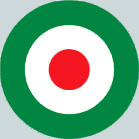
Islamic
Republic of Iran Air Force /نيروي هوايي جمهوري اسلامي ايران
Credit: Roundels of the world
Last update 04-07-2023
To calculate the local (Iranian) calender deduct 621 to the Gregorian (Western) calender.
The
Iranian governement uses the news channels to spread information about
modfications/upgrades; sometimes it is not corresponding to realty or
is misinformation. Quite a few given projects are thought not
to have reached production status. The
Islamic Republic has been lately more open to supply information and in showing aircrafts, but
sometimes mixing realty with propaganda. Good
photos of F-5s have surfaced
thanks to local information agencies. Various very detailed information have been published by Tagweeh Babak in British (mainly) and French aviation magazines.
Northrop
F-5 maintenance and modification/upgrade projects
An
US arms embargo after the declaration of the Islamic Republic of
Iran forced the Air Force toward self-sufficiency,
initially focusing in mantainance of the F-5 fleet, manufacture of
spare parts and later in upgrading
available airframes/avionics and
building new aircrafts.
Maintenance goal was practically reached early, while manufacturing spare parts was only limited. They had to be unofficially imported; fictitious firms were established in several Western countries, trying to forward
these spares to Iran. Some actions were blocked, like the one in February 1993 when British customs seized 7'5000 General Electric J-85-21B blades that the firm DBI Ltd. had manufactured as replacement for
Iranian AF F-5s with an estimated value of USD 1m; in July 2003 US Immigration and Customs Enforcement agency searched 18 US companies suspected of having exported aircrafts (among which F-5) and missile
components to Multicore Ltd, an Iranian front company in London for clandestine procurement of weapons system.
The OUJ complex was established at Nahaja in 1986 to revise, re-construct damaged aircrafts, particularly during the war with Iraq, later to construct new, domestic devoped aircrafts
Reverse engeneering of parts for all aircrafts of US origin was organised through some existing aviation companies: HESA/Iran Aircraft Manufacturing Industries, based at Mehrabad and Isfahan (maintenance, repair of
all types of aircrafts), PANHA
(repairing and mantaining military helicopters and power plants,) GHODS
(electronic devices) and Bashir Basir Industy (design, manufacture and
upgrade of pilotless planes).
Mehrabad
AB houses HESA's main aircraft repair, overhaul and manufacturing
facilities; it boasted by 1995 the capability to manufacture 55% of
engine and fuselage parts for the Northrop F-5s. Important repairs to
damaged airframes considerably slowed down HESA's capability to develop
a new fighter, the Hazarakhsh (see below).
Zam-Zam project
Introduced only in 1995 to add chaff/flare dispenser on outboard underwing pylons. No photos have been shown.
Offogh (Horizon) project
In July 1999 it was announced that this project had improved the
range of the APQ-159 fire
control radar from 32 to 64 km in search modus and 16 to 40 km in
tracking mode and the radar had been equipped with a
90 off-boresight capability, bringing with the Raad project the compatibility to employ Chinese CATIC PL-7, Russian R-60 (AA-8 Aphid) and Sidewinder AIM-9P. Earlier, at an exhibition in Tehran during February 1996,
one F-5E with
an PL-7 missile was put on show.
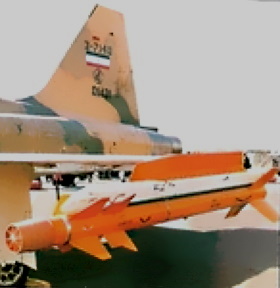 Modification to use Chinese PL-7 (itself a copy of French Matra 550 Magic) air -to-air missiles was studied in 1994 or 1995.
Modification to use Chinese PL-7 (itself a copy of French Matra 550 Magic) air -to-air missiles was studied in 1994 or 1995.
Sattar 1 and Sattar 2 projects
These air-to-surface missiles have been revealed mid-1999; the first is said to have a 20 km range and the second is said to have a completely indigenous design, equipped with a Paveway-type search sensor and a
range
of 30km. These two missiles are intended for use by Iran's F-4E
Phantoms and F-5E Tiger IIs.
Air-to-air refuelling probe
An air-refuelling probe equipped Northrop F-5E was seen for the first time in April 2009. This was a prelude to the modification of the fleet to extend the rather limited range of this fighter, but was not followed on.
Self-sufficency
Improved overhaul/manufacture capacities to increase self-sufficeny were launched in 2008. The Air
Force showed remarkable capability in building parts and overhauling
aircrafts, including Grumman F-14s, Mikoyan
MiG-21s, Mig-29s and
Pilatus PC-7s at "Shahid Babael AB/Izfahan" base.
Initial aim on the way to self sufficency was to manufacture an air-to-air missile, upgrade available avionics and airframes according to necessity. Following projects are known:
Fattar project
Manufacturing an air-to-air missile was high on the self-sufficency requirement. This was realised with "Fatter", consisting of an AIM-9P Sidewinder body and motor and completely new Iranian avionics. The missile is in
service since 2003, reported available in considerable number.
Saeqeh 80
Was an initial uprade using he same designs and airframe as the original Northrop ones.
Kowsar I (fighter)
This
project, unveiled in 2018, was started to give a new lease-of-life to the
remaining Tigers (around 60) in Iranian use and extend their service
life till approximately 2040.
The Air Force Commander in Chief flew an F-5 on a final test flight in March 2018 at Vahdati AFB, recently overhauled in Iran; also anounced in September 2018 was first succcessfull overhaul of an F-5 (together with
an Mirage F.1) in 12.500 man/hours at "Shahid Nasser Habibi AB/Mashad" in Northeastern Iran.
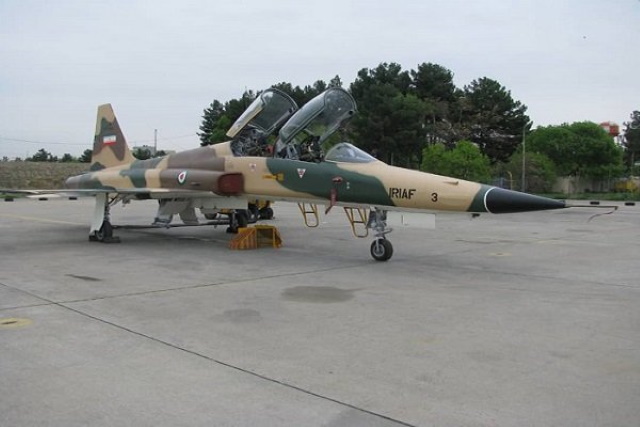 Photo: MEHR Agency
Photo: MEHR Agency
Newly overhauled Northrop F-5F, serial 3 on nose, at Shahid Nasser Habibi AB (Mashad)
Development
and manufacture of "new" aircrafts
Second aim was to develop new aircrafts and avionics; this was realised in several projects. Each was given a name, which, unfortunately, often changed creating quite a confusion. Iranian secret and desinformation
policy does not help.
In April 1997 the Air Force declared that HESA had successfully designed, built and tested its first fighter aircraft; by late 1997 mass production was to start, most probably not exact; most probably it refers to the
Simorgh project (see below)
Simorgh project
The Simorgh (winged creature in the shape of a bird) project involved the
conversion of stored Northrop F-5A and RF-5As into two seaters (mentioned totally
13), needed due to
the shortage of advanced trainer in
the Air Force, replacing old Lockheed T-33As.
HESA was charged to realise it, starting with the conversion at its Izfahan factory from around 1991, later Iran Manufacturing industries (IAMI) at Izfahan/Shahid Babael AB. Northrop documentation was available and
clandestine import of avionics and cockpit transparencies from the USA was organized; work on the first airframe started around 1993. Seven are said to have been delivered
by the end of the year 2002, 9 by 2005
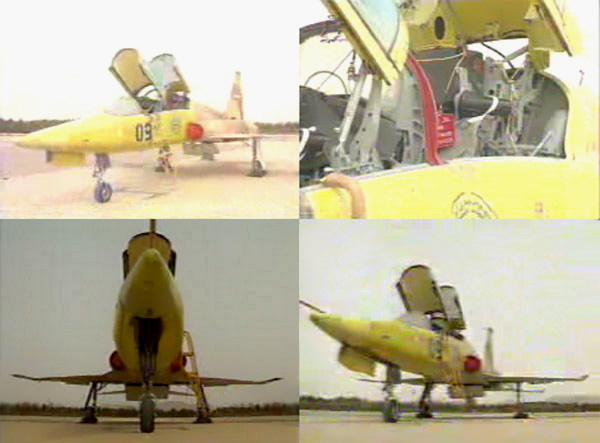 Prototype Simorgh conversion, serial 09. Photo: HESA?
Prototype Simorgh conversion, serial 09. Photo: HESA?

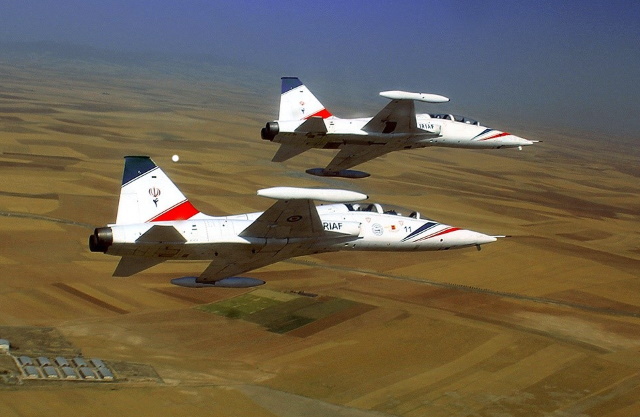 Photo: Fly Angel
Photo: Fly Angel
Overhaul facility showing 1 Simorgh two-seater. 1 Northrop RF-5A modified as Simorgh),
In-flight view of Simoragh code 11 and an unknown one; strangely tail
and nose stripes
single-seater (?, 1 Northrop RF-5A and,
probably, 1 Northrop
F-5E.
seem to be blue/white/red instead of
green/white/red like the national flag.
Unconfirmed
information state that former Vietnamese Northrop F-5A were received at
an unknown date and, at least one, modified to two-seater by HESA for
use by the 85th Squadron, renamed Advanced Training
Squadron. A total of approximately 12 Freedom Fighters, fighter and reconnaissance, were modified to the Simorgh standard.
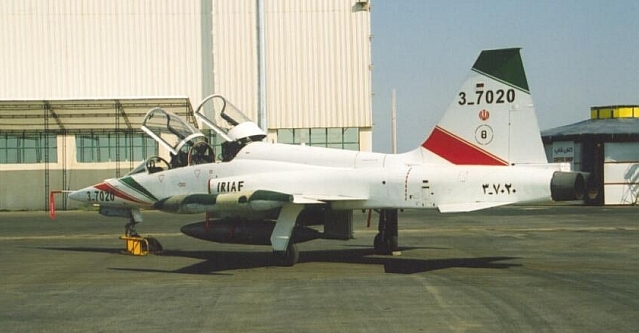
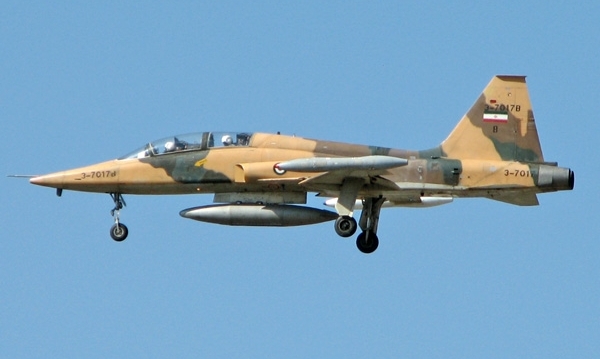
One of two Simorghs shown to the public
was at Kish Island air show in October 2002, serial
3-7017B first
noted camouflaged Simorgh landing
at Tehran-Mehrabad on 17-06-08
3_7020b ex RF-5A.Note
8 on tail showing its home base: 8th Tactical Air
Base-Isfahan.
Photo: Shahram S
Photo: Holger
Müller www.mig-21.de
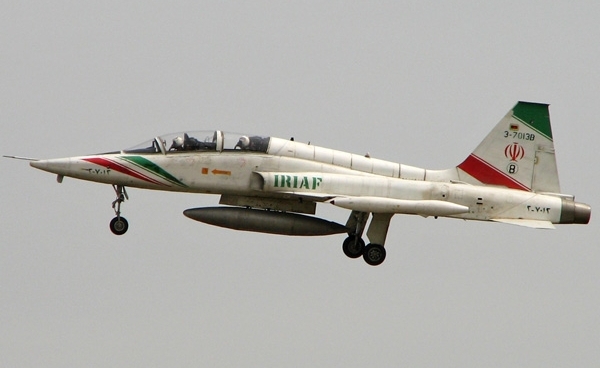 Photo: Shahram S.
Photo: Shahram S.
Simorgh 3-7013B landing at Tehran-Mehrabad on 17-06-08, note
big "Simorgh" drawinging on tail, different
to serial 3_7020B shown above; five
Simorgh have participated at the fly-past in Tehran on 17-06-08.
Following projects are based on the Northrop F-5 and are probably only meant as technological demonstrators to help development of a much more advanced trainer/fighter named Shafagh, allegedly based on the
Russian-Iranian "Project Integral".
 Photo: @Ninja998998
Photo: @Ninja998998
Former Iranian Air Tours Tupolev-Tu 154M used by HESA as testbed for the Russian K-36D ejection-seat.
On top of the tail of was the forward part of a Northrop RF-5A, inside the RF-5A cockpit the new ejection seat.
According to iranian information the name Simorgh has been given to a transport aircraft, flown for the first time om 30-05-23, derived from the IrAn-140.
Silk Road project
Indipendent to all other projects it started as Silk Road II in 2001; the upgraded aircraft was to be manufactured by the Owj complex to include (mostly made in China) avionics upgrade: Sy-80 Fire Control
System (needing to expand radome slightly and delete of one M39 cannon) two MFD, GPS, TACAN, HUD, RWR and PL-5C air-to-air missiles. Seven Chinese, some Russian experts and aeronautical engineers
collaborated with local experts. The first reverse-engined aircraft was used as a test aircraft, followed by another single- and 1 double-seater but trials were abruptly stopped early 2007 by the Chinese
governement, complying with the UN arms embargo to Iran.
Azarakhsh (Lightning) projects
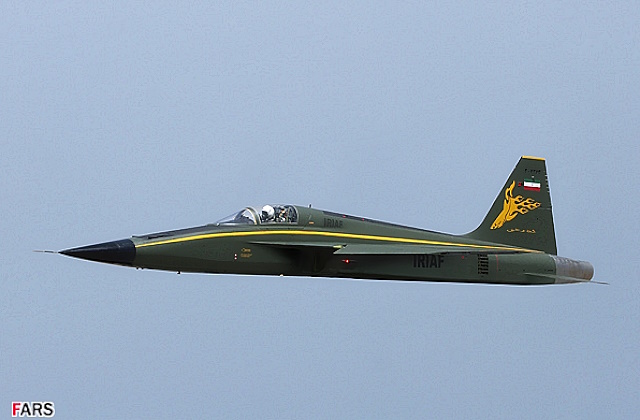 Fake published by FARS information agency
Fake published by FARS information agency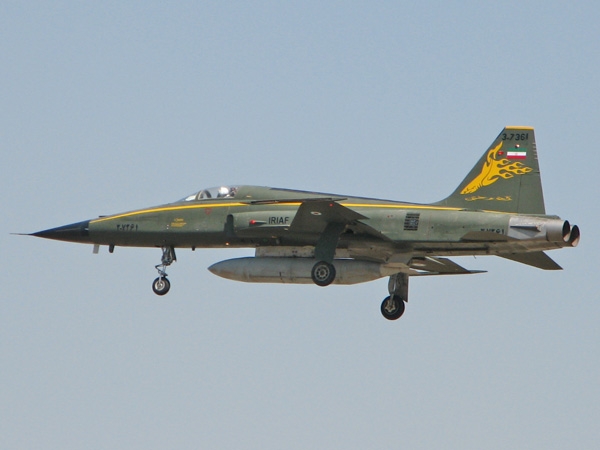 Photo: News Agency/Shahram S.
Photo: News Agency/Shahram S.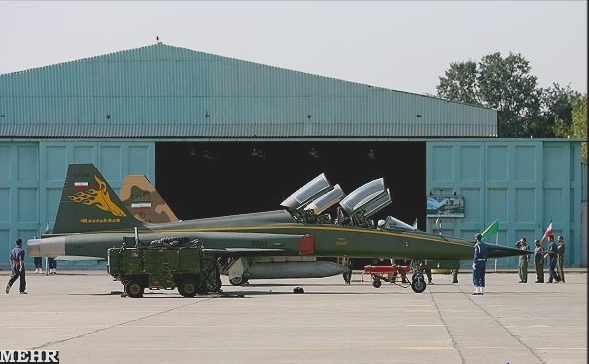
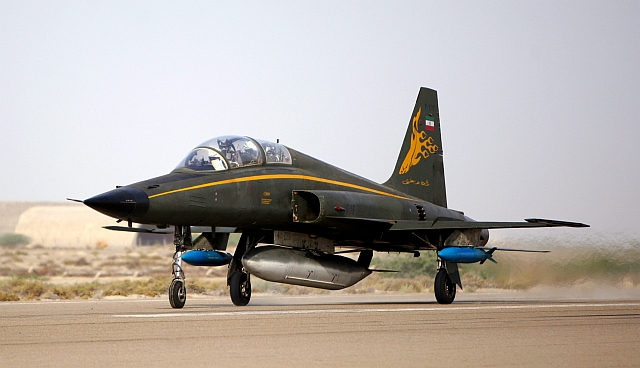
HESA F/B22
This was an new monufacturing Project by HESA on the basis of the
Northrop F-5F; a new bubble canopy, single- instead of doule-seater,
was to replace the original one. Back seat was removed and replaced by
an
extra fuel tank, spin extened for extra fuel. Project was abandoned,
no prototype was built.
Saeqheh I (Thunderbolt) project
Saeqheh
is the most advanced F-5 Iranian modification project known, probably realised
to learn about the effect of twin tail on the aircraft's performance to gain experience for the development of the new
twin-tail fighter named Saeqheh, confirmed by the commander of the Owj Complex (which built the aircaft) in 2017.
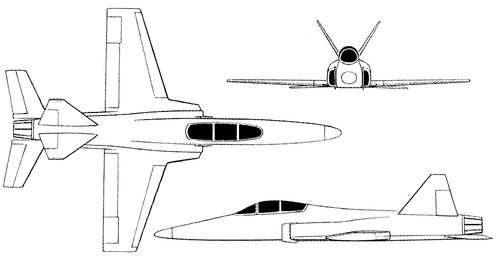 Drawing: Venga
Drawing: Venga
New outboard canted fins
were probaby influenced by the Canadian Venga TG-10, all-composite jet
tainer and light strike aircraft, shown at Le Bourget in 1994, see above.
Saeqheh I was developed
by MATSA Air Force Technology and Electronic Center and the Shahid
Sattari Air Force University of Teheran, starting in 1998, first
flight occurring on 30-05-04. Northrop F-5E airframes, rebuilt
from scrap, were converted to the new configuration (at least one is a former Vietnamese aircraft). Iranian
made, partially digitalized, components have replaced some parts of the
Emerson APG-159 radar; new platforms
have replaced the navigation
systems and radios. It
officially first flew 08-07-04 from Mehrabad AFB, entered service with the Air Force on 06-09-06 and was
claimed to be the first completely designed and manufactured
aircraft in
Iran. The project was transferred to Iranian Aircraft Manufacturing Industries for further development in 2007.
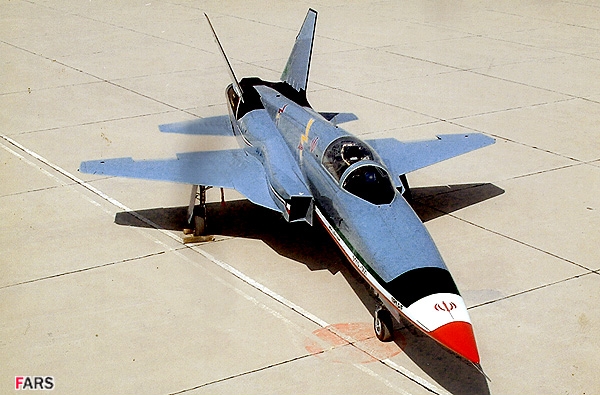 Photo: FARS Agency
Photo: FARS Agency
First
prototype serial S110-001 in original colours. Visible is the
F-18 similar fin
and new square air inlets.
Three
prototypes were built and it seems 9 additional modifications from
Northrop F-5E were planned, against the wishes of the Air Force. Only a
total of five aircraft's serials have been sighted till now now (2022)
in use by the 23rd Fighter Squadron at Tabriz.
Officially the aircraft entered serivice on 06-09-06. Known
is the participation of the first prototype to the exercise
"Blow of Zolfaqar", which began on 19-08-06 ending on 07-09-06, carrying
out attack
missions armed
with Multiple Rocket Launcher,
as shown here accompanied by an F-5F; the aircraft was without
Sidewinder missile rails at wing tips.
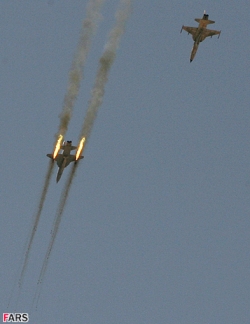
Two additional prototypes flew from
Tehran on 20-09-07. The three aircrafts joined the IRAF on 22-09-07
when they made their appearance to fly-by at the National Army Day.
All three
aircrafts participated to the same event in the year 2008.
Photo: FARS News Agency/Hosseini Fatemi
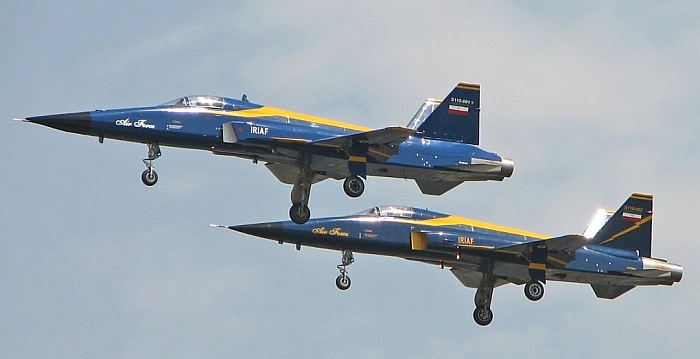
First and second prototype
(background) S110-001/-002 landing at Mehrabad on 22-09-07.
Note second
prototype with modified pitot tube, fin attachment to fuselage, normal
round air inlets, and new, slightly
different paint for each
aircraft,
reminding US Blue Angels aerobatic team colours.
Photo: Shahram S.
Saeqeh
participated actively at air-shows, among which the one at Bandar
Abbas Naval Base on June 02nd, the air-parade at Teheran on Semptenber
22nd, and to exercise Milad-e-Noor-e-Velayat on June 22nd
to 24th 2009 in Southern Iran.
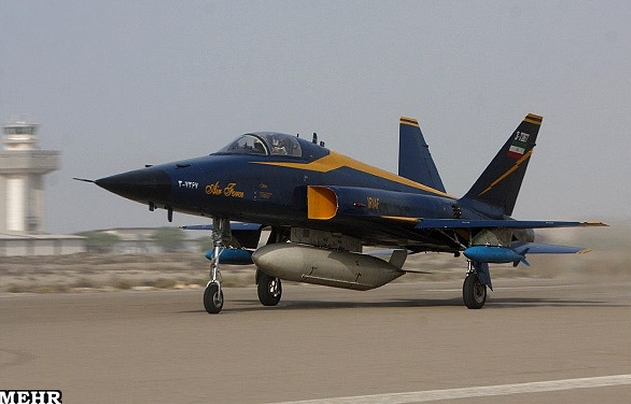

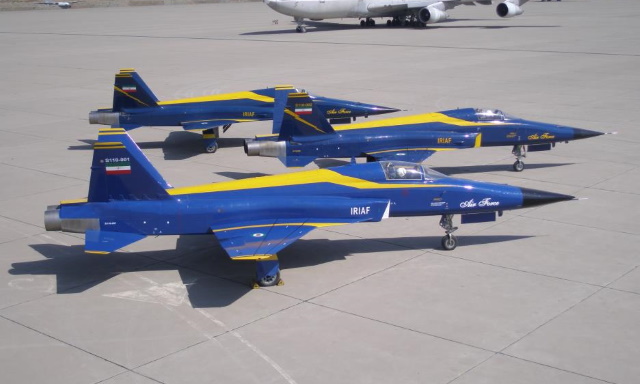
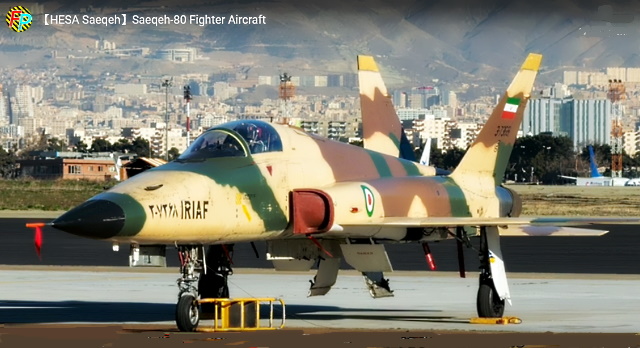
One
Saeqeh 1 equipped Squadron has been formed according to an statement made
by the Commander of the Air Force made on 24-02-10, both for air
defence and ground attack with bombs, rockets and cannons.
This is not tought to be a new Squadron, but the aircrafts integrated
in the 23rd Tactical Fighter Squadron at Tabriz AB. Only 4 prototypes have been photographed at the same time.
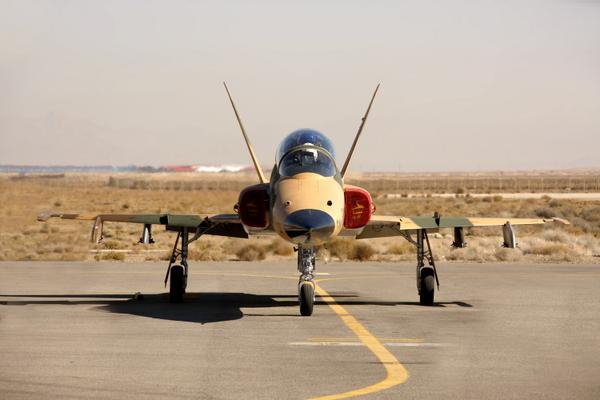
 Photo: DaraZ
Photo: DaraZ
Front view
IAI Saegeh 1, of interest four underwing armament pylons
Over fusesalge view of Saegeh 1, serial 3-7378 2nd Tactical Air Base at Kish Island Air
Show, 28-11-18
Iranian
medias stated in January 2015 that mass production of the Saegeh has
started, unofficial sources mentioned that 24 Northrop F-5s were planned
to be modified. Only four Saeqheh have been shown together,
but probably only six were built
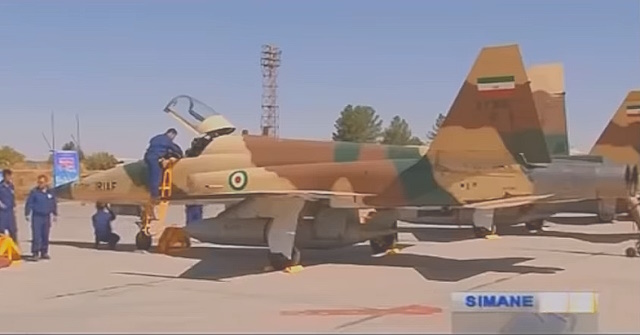 Photo: Simane
Photo: Simane
Saeqeh single-seater being serviced.
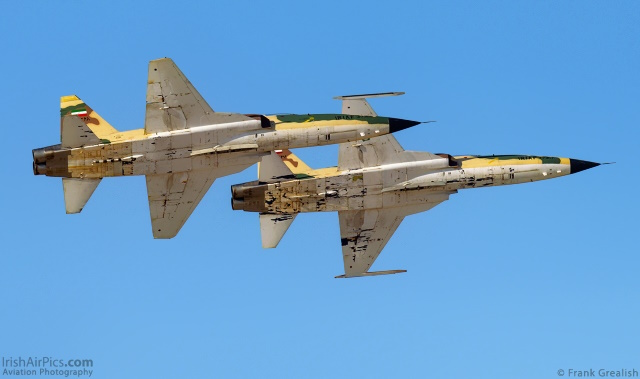 Photo: Frank Grealish/IrishAirPics.com
Photo: Frank Grealish/IrishAirPics.com
Underfuselage view of the two Saegeh at Kish Island Air Show
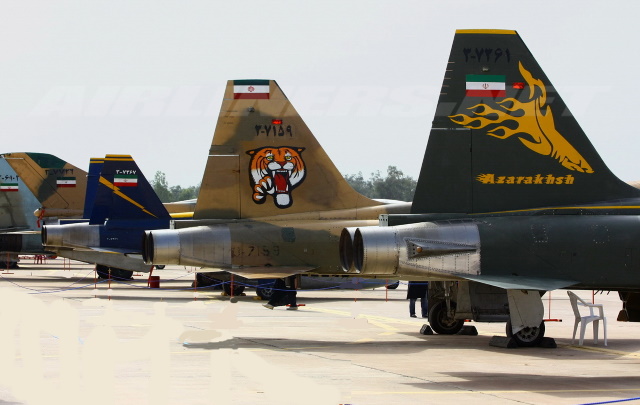 Photo: Saeed Ezadi
Photo: Saeed Ezadi
Line-up of
Azarakhsh, F-5F, Saegeh at Dezful/Vahdati AB on 24-03-10. Note
tiger head on Northrop F-5F
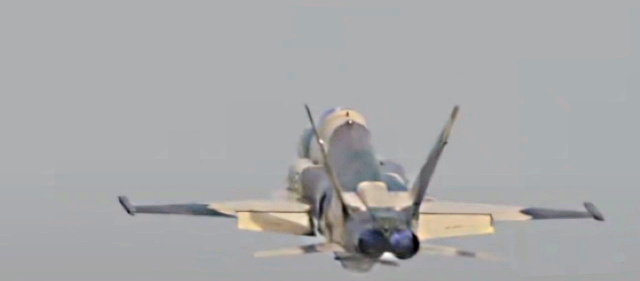
Interesting
tail view of a Saeqeh I
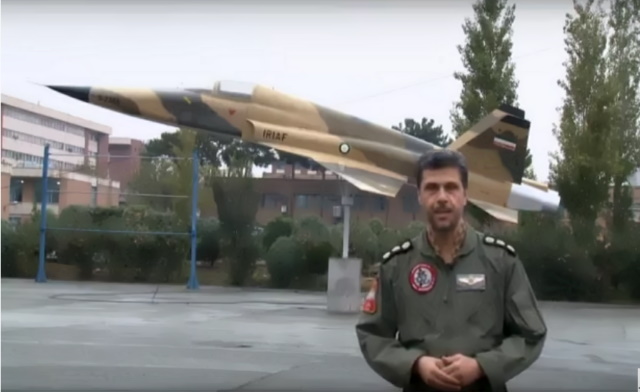
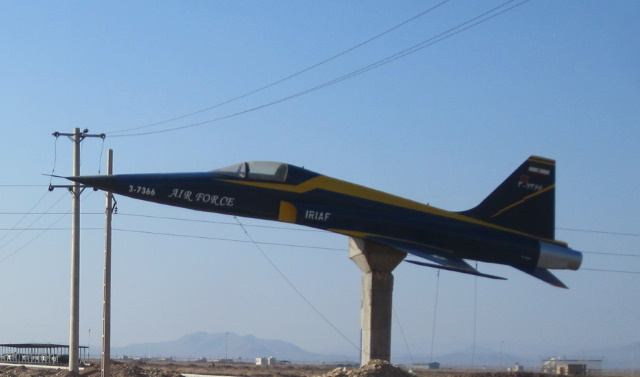
A mysterous Saeqeh I monument was shown at Mehrabad AB on a
video.
Another mysterous monument, serial 7366, colours Saeqeh 1, tail
Northrop
F-5E
Who has details?
Saeqheh II
Three camouflaged two-seaters
were shown for the first time at Teheran-Mehrabad in April 2015
(serialled 3-7368) and on 18-04-17 (serial 3-7182), one at Kish
Island on 17.11.16 (3-7370).
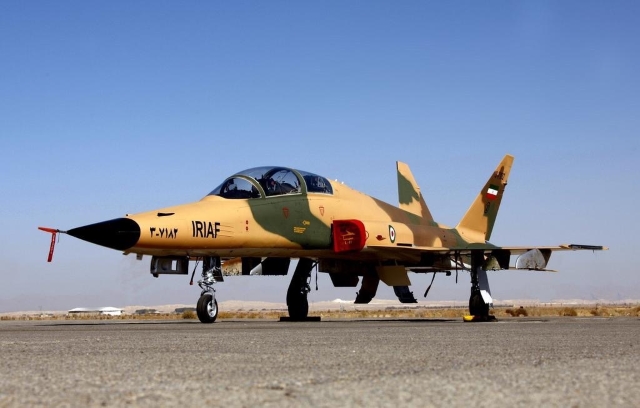
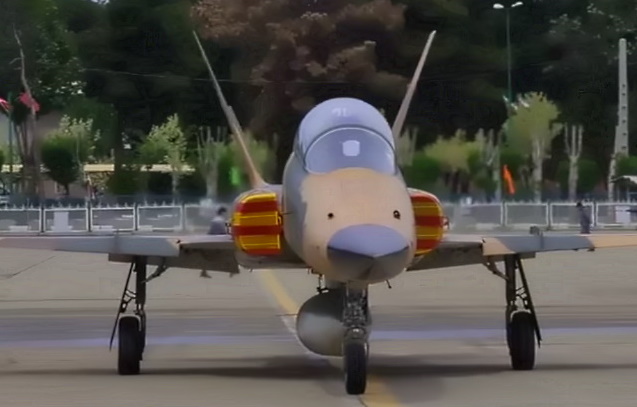
One of the first Saegheh II
to be shown (possibly the prototype), serial 3-7182
Front view of serial 3-7182
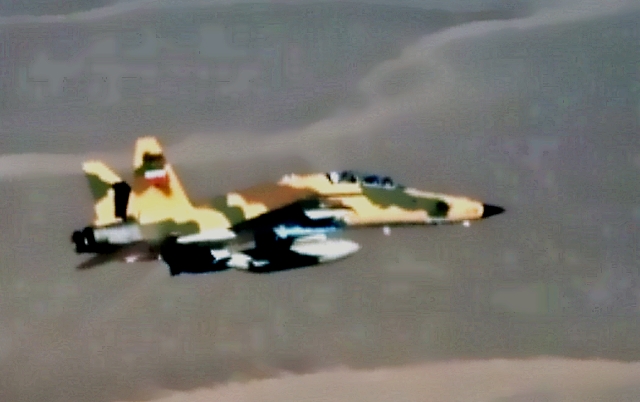 Photo: unknown
Photo: unknown
Poor quality still from a video
of a Saeqeh II carrying an underfuselage tank, underwing training
(possibly)
air-to-air missile (which one?), no wing-tip missile.
According to local soureces there were 8 single- and 2 doubleseaters in service beginning 2020, reverse-engined aircraft was used as a test aircraft, followed by another single- and
1 double-seaters.
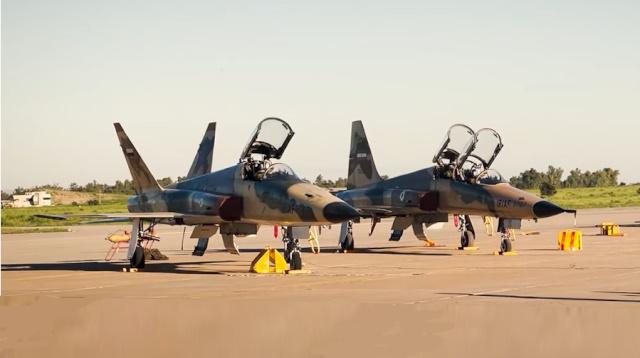 Photo: unknown
Photo: unknown
Camouflaged Saeqeh I in company of a Northrop F-5F (3-7155 or 76?) used duriing an
excercise in 2023
In order to manufacture locally a replacement advanced trainer, called Kowsar 88, components of 3 surviving Northrop RF-5a and 6 Northrop F-5A were planned to be used, announced in 2012. First flight
was foreseen by February 2017 but was delayed due to the use of parts for the mock-up of the new fighter: Qather F-313. A total of 16 Kowsar was foreseen to be built, 11 Simorgh to be still used until
deliveries of the new aircraft was
completed.
A new modernisation effort was started 2009, named Kowsar in 2018. IAMI was contracted to modify 47 Northrop F-5E and 16 Northrop F-5F and manufacture 4 new aircrafts to make losses good. The first of
these lasts flew on January. Several aircraft from the original project were used to fasten development. All (many) short-comings of earleir (Silk Road) project were to be settled and substituted by Iranian-built
items,even integrating Pilatus PC-7 and Bell AH-1J parts Iranian built radar, Bayynet II copy of the Chinese SY-80) was also installed.
on the Russian K-36, as used on the MiG-29) and J-85-GE-21 turbojet, called "Owj", also made in Iran.
As
armament it carried one 20 millimeter cannon, could be fitted with 2
Fatir missiles (Iranian built AIM-9 Sidewinders), 2'400 kg of
weapons with 5 minutes combat at maximum power/at sea level and several
types of Hydra rocket launchers.
An Italian Grifo radar (Chinese model or its local model) is also carried.
The prototype airframe had already been locally manufactured earlier, difficulty at the time was to obtain new avionics, thus being unable to launch a full scale production. All this according to Iranian information;
quite a lot for a Tiger copy!
One new aircraft was shown to President Rohani visiting an armament exhibition in Teheran on 21-08-18. Mentioned this as a prototype two-seater (serial 3-7400) allegedly fully developed in-country by
First flight of first two Kowsar modernized Northrop F-5Fs was respectively on December 2018 and January 2020 and delivered officially to the IRIAF on 25-06-20. The Air Forces commander stated that
15 trainers would be delivered by 2022. All this according to Iranian information; quite a lot for a Tiger copy!
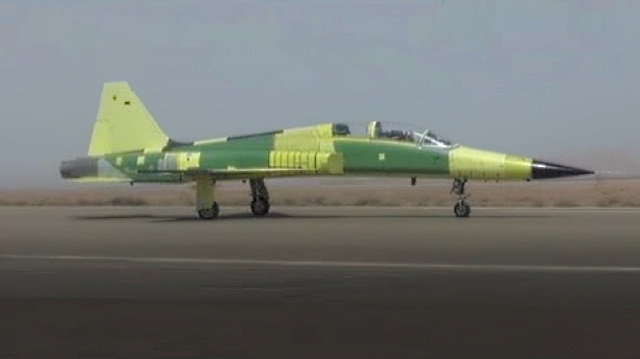
Kowsar trainer seen in primer colours, showing modifications.
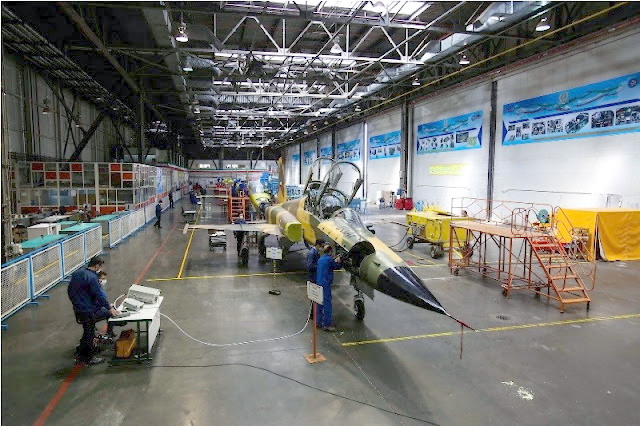
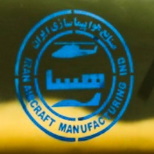
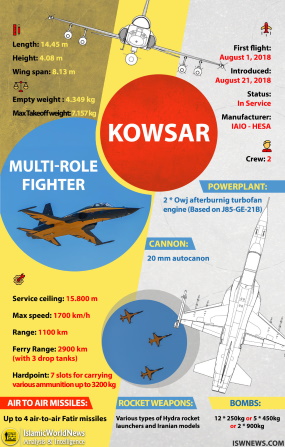

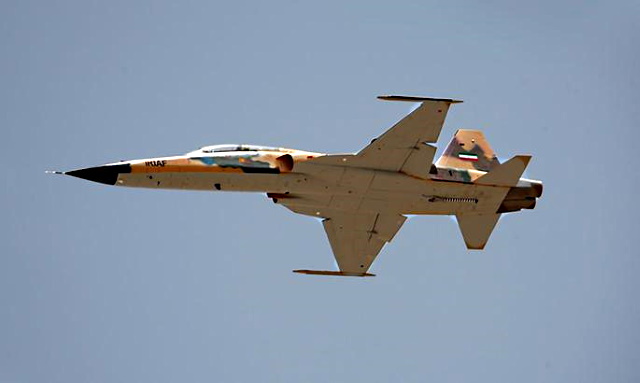
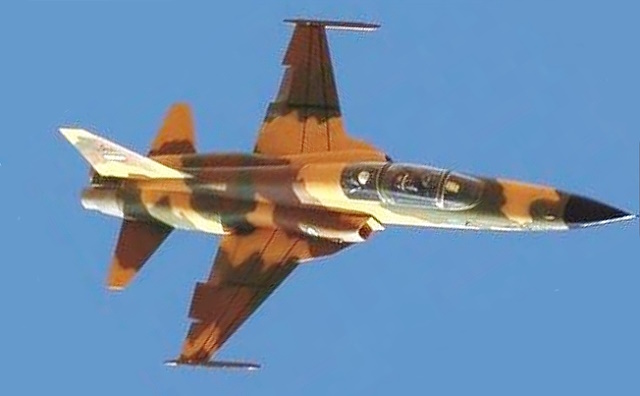
Kowsar
trainer overfuselage Photos: MEHR/ Iranian Ministry of Defence
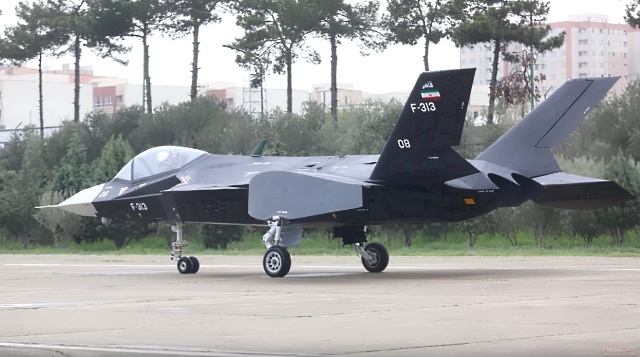
Prototype F-313 08.
Photo: Irib News